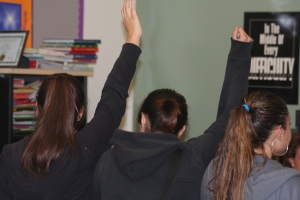McPhatter School, A Lesson in Philanthropy
Playwrights Project was recently awarded a grant from students at McPhatter School in San Diego, who took part in a program with Main Street Philanthropy. Read on below for details on this amazing and unique process!
What is Main Street Philanthropy?
Main Street Philanthropy was founded by Ryan Ponsford, a wealth management professional who helps families with philanthropy. He spoke with his friend Scott Kreinberg, a teacher at McPhatter School, who thought his students could benefit from learning more about philanthropy–specifically the process leading up to, and the actual act of giving donations to local non-profit organizations. The Main Street Philanthropy Challenge is a six week program that brings the lessons learned through philanthropy from the ultra wealthy to the students and families of Main Street.What was the philanthropy process?
Over six weeks, students worked in groups to research non-profit organizations that shared their values and addresssed areas where students would like to see change (personal values, issues, and social concerns). After reporting their findings, students would agree on organizations to further research. They were guided in performing both Qualitative Analysis (through volunteering and individual interviews) and Quantitative Analysis (through a review of the non-profits’ IRS Form 990). Students would then meet and agree on how to distribute their funds from Main Street Philanthropy (funded by Giving Hope Worldwide Foundation).Students met with Playwrights Project’s Executive Director Cecelia Kouma. They had a worksheet of 23 questions to ask a non-profit before donating, which included questions on the Mission and history of the organization, programs and services offered by the organization, board and volunteer information, and financial history. Students also looked through our IRS Form 990 to find more information on expenses, fundraising and other revenue to determine the financial sustainability. Organizations that received funding from the McPhatter students were San Diego Humane Society, Father Joe’s Village, Becky’s House, PLNU Health Promotion Clinic, ARTS (A Reason to Survive), & Playwrights Project.
How can the students benefit from this type of project?
Students benefitted from the Challenge in several unique ways: increased trust and communication among participants, expansion of preparedness and understanding of financial concepts, an appreciation for the need and purpose of philanthropy in our society, and for many, increased self-esteem and confidence by being on the giving side of philanthropy.More information on McPhatter School:
McPhatter School is part of the Juvenile Court & Community Schools system with the San Diego County Office of Education. McPhatter acts as a placement site for students who are on a long-term suspension, expulsion or zero tolerance from San Diego Unified. They are often referred by the Juvenile Probation Department, the Department of Social Services, or the Juvenile Court. A large number of the students are homeless or in the foster care system, many of which are living with friends or family other than their biological parents. Of those enrolled, 85% of students are from socio-economically disadvantaged situations; 34% are considered “English Learners.” The goal of McPhatter is to build student self-esteem, increase course completions, and return students to a traditional school district. Students live at home and attend school during the day. The average stay for a student enrolled in McPhatter is 6 months or longer.What is the history between Playwrights Project and McPhatter School?
Playwrights Project has brought in-school playwriting residencies to McPhatter for the past two years, and students have also attended the Plays by Young Writers festival. Mr. Kreinberg’s class attended a performance of Switch by Lisa Kirazina (from the Telling Stories: Giving Voice to Foster Youth program) during last year’s play festival.We are honored to have been selected by the McPhatter students to receive their donation, and agree that this unique giving challenge was an amazing experience for both the students and our organization! Thank you to McPhatter and Main Street Philanthropy!!
http://playwrightsproject.wordpress.com/
http://playwrightsproject.wordpress.com/2011/09/23/mcphatter-school-a-lesson-in-philanthropy/
